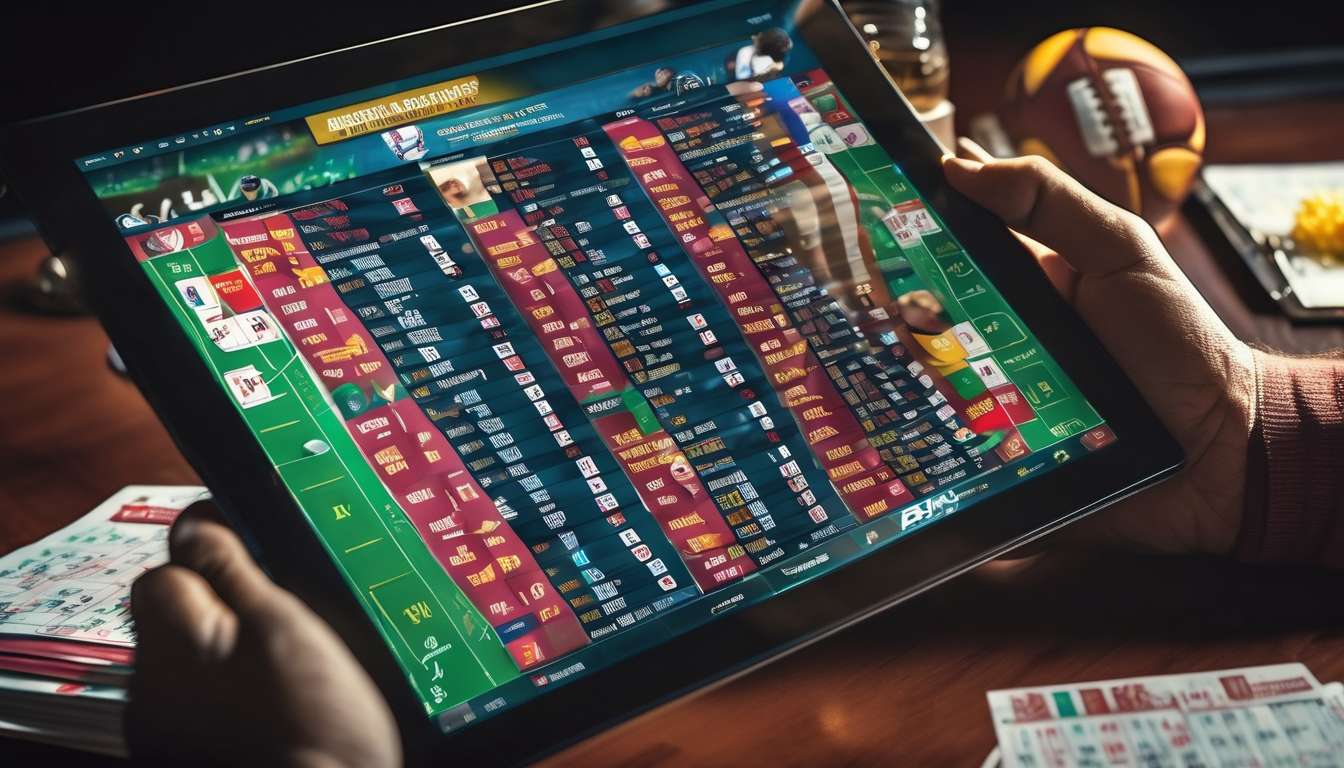When we first dip our toes into the world of betting, it can seem like an overwhelming sea of numbers and jargon. But fear not, for we are here to demystify the process and make it accessible for beginners like us.
Understanding betting odds is the first crucial step in this journey. By grasping the basics, we can make informed decisions rather than relying on sheer luck. Together, we will explore the different types of odds and how they reflect the probability of an event and potential payouts:
- Fractional Odds: Commonly used in the UK, these odds show the ratio of the profit to the stake.
- Decimal Odds: Popular in Europe, these odds represent the total payout, including the original stake.
- Moneyline Odds: Used mainly in the US, these odds indicate the amount you need to bet to win a specific amount, or how much you can win with a specific bet.
As we delve deeper, we’ll learn how to:
- Calculate implied probabilities to understand the likelihood of an event occurring.
- Compare the odds offered by various bookmakers to find the best value.
By the end of our exploration, we will have laid a solid foundation, empowering us to engage with betting more confidently and strategically.
Let’s embark on this enlightening adventure together.
Fractional Odds
Fractional Odds Overview
Fractional odds, commonly used in the UK, express how much profit can be made relative to the stake. This traditional format allows bettors to feel connected to a long-standing betting culture.
Understanding Fractional Odds
-
When odds are presented as 5/1, it signifies:
- For every £1 bet, there is a potential profit of £5.
- This makes it straightforward to calculate potential returns.
-
For odds like 3/2:
- For every £2 staked, the profit would be £3.
- Additionally, the original stake is returned.
Community and Culture
Understanding these odds helps bettors make informed decisions, increasing their confidence in placing bets. By mastering fractional odds, bettors are not just participating in betting but are also engaging in a vibrant community.
- Benefits include:
- Exchanging insights with fellow enthusiasts.
- Gaining a deeper appreciation for the nuances of betting odds.
This shared knowledge fosters a sense of camaraderie and enriches the overall betting experience.
Decimal Odds
Decimal Odds Overview
Decimal odds, commonly used in Europe and Australia, offer a straightforward approach to calculating potential returns by simply multiplying the stake with the odds. This system is intuitive and easy to understand.
Example Calculation
- Given decimal odds of 2.50
- A $10 bet would yield a total return of $25
- Calculation: 2.50 x $10 = $25
This method provides clarity by showing not only the potential winnings but also the total payout, including the original stake.
Advantages of Decimal Odds
- Clarity and simplicity in understanding potential outcomes
- Widely used across major sports betting platforms
- Facilitates easy comparison of odds and potential returns
By embracing decimal odds, we can confidently navigate the betting world with a sense of belonging to a broader community that values simplicity and transparency in wagering.
Moneyline Odds
Moneyline Odds Overview
Moneyline odds, prevalent in the United States, may initially seem complex but quickly become intuitive once their structure is understood. These odds are expressed as either a positive or negative number.
Understanding Moneyline Odds
- A positive number indicates how much profit you’d make on a $100 bet.
- A negative number shows how much you need to bet to win $100.
Example: Betting on a Football Game
-
Underdog Example: If the underdog has odds of +200, betting $100 would result in a $200 profit if they win.
-
Favorite Example: If the favorite has odds of -150, you would need to wager $150 to win $100.
Benefits of Understanding Moneyline Odds
This system allows bettors to quickly assess which team or player is favored and by how much. It fosters a sense of community as bettors compare and strategize together. Understanding these betting odds enhances confidence and connection in wagering endeavors.
Implied Probabilities
Implied probabilities help us understand what the odds suggest about the likelihood of an outcome occurring. Betting odds reflect both potential payouts and the bookmaker’s assessment of an event’s chances. By converting these odds into implied probabilities, we can better gauge whether a bet offers value or if the odds align with reality. This understanding connects us with a community of informed bettors, all striving to make smarter decisions.
To calculate implied probabilities:
For decimal odds:
- Divide 1 by the decimal odds.
-
Multiply the result by 100 to get a percentage.
- For example, decimal odds of 2.50 would convert to a 40% implied probability.
For fractional odds:
- Divide the denominator by the sum of the numerator and denominator.
- Multiply the result by 100.
This shared knowledge about betting odds empowers us to identify when the odds are in our favor, fostering a sense of belonging in the betting community.
Comparing Bookmaker Odds
Comparing Odds for Enhanced Betting Strategy
When we take the time to analyze and compare betting odds across various platforms, we become more informed participants in the betting community. This practice not only boosts our potential returns but also strengthens our sense of belonging as savvy bettors who make well-informed decisions.
Benefits of Comparing Odds:
-
Maximize Potential Profits: By observing the differences in betting odds offered by each bookmaker, we can identify which one offers the most favorable odds for a particular event. This gives us an edge, allowing us to maximize potential profits.
-
Understand Market Variations: Bookmakers often have slight variations in odds due to their unique market assessments. Even small differences can significantly affect our overall returns.
Empowerment through Knowledge:
In our shared journey of understanding betting odds, embracing this practice of odds comparison empowers us. We become part of a knowledgeable collective, always seeking the best value and honing our betting acumen together.
Probability vs. Payouts
Understanding the Relationship Between Probability and Payouts
Understanding the relationship between probability and payouts is crucial for making informed betting decisions. When we look at betting odds, we’re not just seeing potential winnings; we’re also seeing the implied probability of an event happening. It’s like being part of a community that deciphers the hidden language of numbers, where we all strive to make smart choices together.
Breaking Down Betting Odds
Let’s break it down: if the odds are expressed in a fractional format, for instance, 5/1, it’s telling us that for every 1 unit we wager, we could win 5 units. But it also implicitly suggests the bookmaker’s view of the probability.
To calculate this probability:
- Divide the denominator by the sum of the numerator and denominator: ( \frac{1}{5+1} = 0.1667 ).
- This means there’s about a 16.67% chance of winning.
Becoming a Savvy Bettor
By understanding how probability influences payouts through betting odds, we join a group of savvy bettors who use this knowledge to make better decisions, sharing in the wins and losses together.
Making Informed Bets
To make informed bets, we need to combine our understanding of probability with research and strategy.
Community Engagement:
- Embrace the community around us.
- Share insights and experiences to enrich our betting approach.
Research and Analysis:
- Analyze team stats, player performance, and weather conditions to build a foundation for smarter decisions.
- Understand that betting odds reveal both potential payouts and the implied probability of an event.
Data-Driven Decisions:
- Avoid relying solely on intuition.
- Dive into data and trends that could influence outcomes.
Value Bets:
- Spot value bets where odds suggest a lower probability than our research indicates.
- Focus on identifying opportunities where the odds are in our favor, not just picking winners.
Bankroll Management:
- Manage our bankroll wisely by setting limits to avoid emotional decisions.
By staying informed and engaged, we not only enhance our chances but also strengthen our sense of belonging in the betting community.
Empowering Your Betting Strategy
To empower our betting strategy, we need to integrate our research and insights into a cohesive plan that maximizes our advantages.
Understanding Betting Odds is crucial as it allows us to make more informed decisions and feel more connected to our community of fellow bettors. Let’s start by analyzing the odds carefully:
- Odds reveal the implicit probabilities of each outcome.
- They help us identify value bets where the odds seem favorable compared to our own calculations.
Keeping track of our bets is essential:
- Note what works and what doesn’t.
- This reflection allows us to refine our strategy.
Building camaraderie and collaboration is also important:
- Share insights and learn from others.
- Collaborate with like-minded individuals through forums or local groups.
- Strengthen betting skills and foster a sense of belonging.
Staying informed about the latest trends and strategies ensures that our approach remains dynamic and effective:
- Continuously adjust our strategy as needed.
- Enhance our understanding and enjoyment of the betting world.
Together, these steps will help us to enhance our betting strategy, ensuring greater success and a more rewarding experience.
What are the common mistakes beginners make when interpreting betting odds?
Understanding Betting Odds
When we’re new to it, interpreting betting odds can be confusing. One mistake we often make is not understanding the different odds formats. It’s easy to get mixed up between:
- Decimal odds
- Fractional odds
- American odds
Assessing Odds and Probability
Another common error is not factoring in probability when assessing odds. We might focus too much on potential payout and overlook the likelihood of an outcome.
These missteps can lead to poor betting decisions.
How do bookmakers set the initial odds for an event?
We set the initial odds for an event based on a variety of factors. These factors can include:
- The teams or participants involved
- Their past performances
- Current form
- Relevant external variables (e.g., injuries or weather conditions)
By carefully analyzing all these elements, we aim to provide accurate and enticing odds that reflect the probabilities of different outcomes.
Our goal is to create a balanced book that attracts bettors while mitigating risks.
What role do betting exchanges play in the betting market?
Betting exchanges revolutionize the betting market by allowing individuals to bet against each other rather than against a bookmaker. This peer-to-peer system creates opportunities for better odds and more flexibility for bettors.
Advantages of Betting Exchanges:
- Enhanced Transparency: Bettors can see the odds and bet amounts clearly, leading to more informed decisions.
- Increased Competition: With multiple bettors participating, odds often become more competitive.
- Greater Control: Bettors have the ability to set their own odds and decide which bets to accept or reject.
Impact on the Betting Industry:
Overall, these platforms play a significant role in shaping the modern betting landscape by providing an alternative to traditional bookmakers. Betting exchanges enhance transparency and competition, offering us more control over our bets.
Conclusion
Now that you’ve grasped the basics of betting odds, you’re equipped to make smarter choices in your wagers.
Understanding Different Types of Odds:
-
Fractional Odds: These are commonly used in the UK and represent the ratio of the amount won to the stake placed.
-
Decimal Odds: Popular in Europe, these odds show the total payout rather than just the profit.
-
Moneyline Odds: Common in the US, these odds indicate how much you need to stake to win a certain amount or how much you will win on a specific stake.
Implied Probabilities:
- By understanding implied probabilities, you can determine the likelihood of an event happening based on the odds provided.
Strategies for Informed Betting:
-
Compare Bookmaker Odds: Always compare odds from different bookmakers to ensure you’re getting the best possible value for your bets.
-
Make Informed Bets: Use your understanding of odds and probabilities to make strategic decisions rather than relying solely on luck.
Remember, it’s not just about luck – it’s about strategy and knowledge. Keep empowering your betting approach and watch your success grow.
Happy betting!




